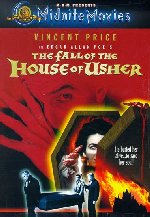
By the year 1960 Roger Corman had all ready directed some 16 films in his 5 years of being a director. To say the least, his reputation as to being a fast and dependable director was locked in. But by the time it came to do what would become THE FALL OF THE HOUSE OF USHER, he had become burnt out on the super quick black and white film he had become king of.
He successfully persuaded the film studio to let him expand his budget and shooting schedule to make a bigger film than he had ever done before.
The results were THE FALL OF THE HOUSE OF USHER (or HOUSE OF USHER as it says on the title card). The end results were also much more accomplished than anyone could have really hoped for.
Based on the story by Edgar Allen Poe, HOUSE is the story of a family that has been driven insane by years of corruption and wrong doings.
The film opens with a man traveling through a barren forest lacking in living vegetation. He arrives at a fog shrouded mansion and is greeted at the door by a slightly strange butler. We find out that the man, Philip Winthrop (played by Marc Damon) is the fiancÚ of Madeline Usher (played by Myrna Fahey) whom he met while at college. The two are in love but are opposed by Madeline's brother, Roderick Usher (played by Vincent Price in brilliant performance) who is also seemingly going mad.
Through out the film we watch as Philip grows ever more frustrated with Roderick and his attempts to drive Philip away without Madeline, and we watch Roderick slip further into the clutches of madness, or is he really completely sane? The Butler Bristol (played in a very nice low key manner by Harry Ellerbe) is bit of a devils advocate in the film. You never really get the feeling that he is there to stand in the way of Philip, but at the same time he is a very frustrating person because he just doesn't come clean with all that he knows.
What works in the film is that the house feels very much alive, and yet the people are also on the verge of insanity. Corman at one point in the commentary mentions that the studio pushed him into using the Cinemascope process, but he didn't know if a Horror film should be in "scope". In all reality, the scope of the film is one of the things that helps the film work so well. The cast is limited to only four characters (we see more people, but they come in a dream sequence only), so on screen we never have more than that at any one time, which helps the house seem that much larger, and then add into it the depth that shooting in scope will bring. The house just feels much larger and colder than it would on a smaller size picture.
The film also works on many psychological aspects. We are never sure if the Ushers are insane, or if the house is indeed cursed and surely Bristol helps to keep us in the dark. The film is also a much more visionary film than anything we had been treated to by Corman up until this point. The use of colors is beautiful, especially when realized that he had only worked in black and white up until this point.
MGM brings us THE FALL OF THE HOUSE OF USHER in a beautiful 2.35:1 picture. The picture itself is pretty clean of grain and other debris. It may not be on par with a film of a more recent vintage, but for a film that is 32 years old, this thing looks great! The colors all come through strong a very pleasing.
The sound is exactly as it should be. Mono, and very clear. No reason for complaints here.
For bonus stuff we have a trailer and a commentary track.
The commentary by Corman is a treat to listen to. He remembers enough for background stories, but also gives us a bit of a crash course on low budget filmmaking, but also gives us the info on how times have changed. He keeps it all moving and always interesting. At one point he lets us know that he is just going to sit and watch the film for a few minutes! Kind of nice to know that he is still interested in his film and it can still wrap him up! He also lets us know that the portraits that were in the movie all went home with the cast and crew, he ended up with the Vincent Price! Price, on the other hand, left with the sea captain.
THE FALL OF THE HOUSE OF USHER was to me what films by Hammer where to others when growing up. This film and the other Corman / Poe films were my first exposure to extreme color use in films and the brilliant gothic feel. The film still works today thanks to stellar performances, set design, and a rock solid direction! I would love to see Roger Corman work in this style again (FRANKENSTEIN UNBOUND was a huge treat, but give us more!!!), but if that never happens, atleast MGM has given us this brilliant presentation of the film! And to think it only cost me a little over $10!
Review by Carl Isonhart
| Directed by Roger Corman |
| Released by MGM |
| Ratio - Widescreen 2.35:1 (Anamorphic) |
| Audio - Optional English & French Dolby Digital Mono |
| Extras : |
| Audio Commentary With Roger Corman, Original Theatrical Trailer |